Descendant of the Original Charter Oak
Historical marker location:
27 Battle Street, Somers, Connecticut
( Marker is at the intersection of Battle Street and Main Street, on the right when traveling south on Battle Street.)
Marker installed: 2002







© OpenStreetMap contributors
Loading...
Searching for other points of interest within 3 miles of this location.Connecticut was one of the original 13 colonies and played a significant role in the American Revolution. Many important battles and skirmishes were fought in Connecticut, including the Battle of Ridgefield and the Battle of Groton Heights.
About Tolland County
Tolland County Timeline
Tolland County, located in the northeastern part of Connecticut, has a rich history that dates back to its founding in 1785. The area was originally inhabited by Native American tribes, such as the Mohegan, Nipmuc, and Pequot. European settlers began arriving in the region in the 17th century, establishing farmsteads and small communities.
During the American Revolution, Tolland County played a significant role. The county was known for its strong support of the Patriot cause, and many residents volunteered to serve in the Continental Army. Tolland even hosted General George Washington in 1776 as he traveled through the region. The towns of Tolland, Hebron, and Coventry were particularly active during this period.
In the 19th century, Tolland County experienced rapid industrialization. The advent of the textile industry brought mills to towns like Rockville and Stafford Springs, boosting the local economy and population. The county also became a center for agriculture, with dairy farming and tobacco production being major industries. The construction of railroads further connected Tolland County to regional markets, stimulating its growth and development.
In the present day, Tolland County continues to be a picturesque and vibrant region. Its historic towns and villages, such as Ellington, Columbia, and Somers, retain their small-town charm and showcase the county's rich architectural heritage. The county also boasts an assortment of parks, forests, and lakes, making it an attractive destination for outdoor enthusiasts. Tolland County's history, from its Native American roots to its industrial boom, has shaped its character and provided a strong foundation for its present-day communities.
During the American Revolution, Tolland County played a significant role. The county was known for its strong support of the Patriot cause, and many residents volunteered to serve in the Continental Army. Tolland even hosted General George Washington in 1776 as he traveled through the region. The towns of Tolland, Hebron, and Coventry were particularly active during this period.
In the 19th century, Tolland County experienced rapid industrialization. The advent of the textile industry brought mills to towns like Rockville and Stafford Springs, boosting the local economy and population. The county also became a center for agriculture, with dairy farming and tobacco production being major industries. The construction of railroads further connected Tolland County to regional markets, stimulating its growth and development.
In the present day, Tolland County continues to be a picturesque and vibrant region. Its historic towns and villages, such as Ellington, Columbia, and Somers, retain their small-town charm and showcase the county's rich architectural heritage. The county also boasts an assortment of parks, forests, and lakes, making it an attractive destination for outdoor enthusiasts. Tolland County's history, from its Native American roots to its industrial boom, has shaped its character and provided a strong foundation for its present-day communities.
Tolland County Timeline
This timeline provides a concise overview of the key events in the history of Tolland County, Connecticut.
- Tolland County was established on October 13, 1785.
- In 1786, Tolland became the county seat.
- In the early 19th century, the county experienced growth in agriculture and industry.
- During the 19th century, Tolland County's population continued to increase.
- In the 20th century, the county saw further industrial development and expansion of transportation infrastructure.
- Tolland County is currently home to various historical sites and landmarks, showcasing its rich history.